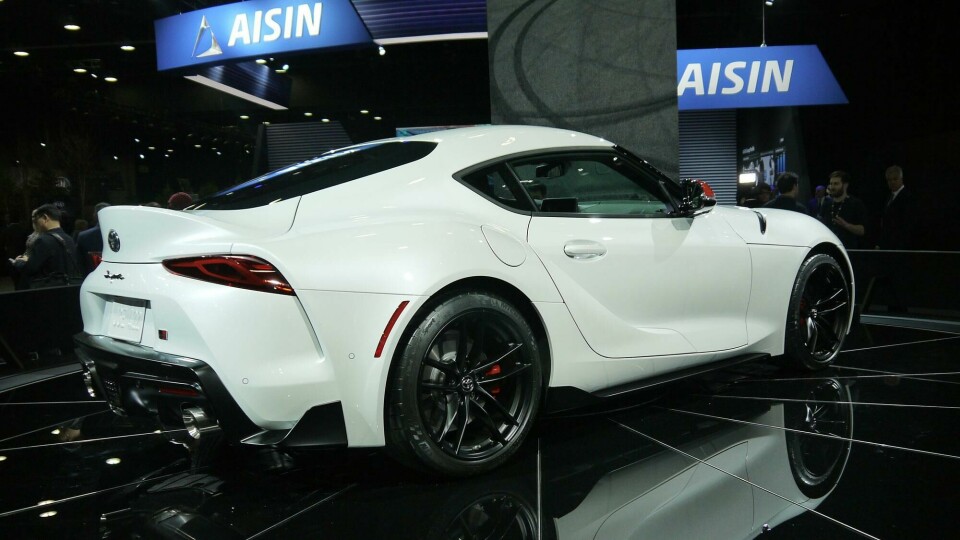
Detroit 2019: Toyota’s Tetsuya Tada on the new Supra
A Q&A with the father of the fifth Supra
Car Design News spoke to Tetsuya Tada, chief engineer of Toyota’s Gazoo Racing division, about balancing competing priorities in the new Supra sports coupé…
CDN: What were your key goals when the Supra development project started?
Tada: The main focus was to make sure that the feeling of driving the car and the visual looks of the car embody what the Supra has always been, and what it symbolises. With the exterior, you can look at it from any angle and know right away that it is a Supra.
All five generations of the Supra have had an inline six-cylinder engine and rear-wheel drive. That layout that was something I always wanted to make sure was incorporated in this vehicle.
Trying to offer a new definition of driving pleasure was another primary goal for this car.

CDN: The car was created in collaboration with BMW, which meant two sets of engineers and two sets of designers had to balance their ideas. Was that a particular challenge?
Tada: I personally had experience of working with Subaru before, and with BMW of course the major difference was that the countries and languages were different, so that was a little challenging. But the fact was that Toyota had a specific vision of what the Supra should be, and we were able to make that a reality through this process.
With the Subaru BRZ and our GT86, one of the goals was to share as many components as possible – that was a key part of the business case. But for this vehicle, because the positioning is slightly higher, it meant we were free of those kinds of restrictions.
So, BMW had their own vision of what the Z4 should be, we knew exactly what the Supra should be, and everybody focused on what they wanted to build… and that’s how it worked out. It wasn’t a very stressful project.

CDN: You must have had arguments…
Tada: There were no arguments per se, but let’s say that trying to settle on the initial dimensions of the vehicle involved a lot of back and forth negotiation.
Of course, there are standardised design rules – Toyota has its own protocol, and of course BMW had its own, and if both companies won’t budge you could end up with a car that looked like a tank… so that was out of the question. So I spent a lot of time making sure those discussions were properly done. Both sides learned a lot from those discussions and the end result is something I’m very happy with.

Left to right: FT-1 Concept, Supra Mk.IV, 2000GT
CDN: The profile of the new Supra is strongly reminiscent of the classic 1967 Toyota 2000GT. To what extent was that car a touchstone during development?
Tada: It was definitely a big influence. The side view has a distinct reminiscence, as does the driving flavour; I tried to put that into it. The last time I drove a 2000GT was about three years ago – a very good condition car, at the track – and it was something that would react exactly as the driver wanted it to. It was great fun.
The 2000GT is also a very small car, and we made efforts to ensure the new Supra was on the small side. The wheelbase is shorter than a GT86. Everybody is surprised by that. Small size makes the vehicle lighter and easier for the driver to control. You can visualise and feel where the tyres are on the road.

CDN: Were the visual proportions as important to you as the mechanical weight distribution?
Tada: Trying to decide where the bulk of the mass would sit took a long time, but we also spent a lot of time on the visual proportions. That was also a part where designers from both companies had the longest discussions.
CDN: Who wins when the visual and engineering priorities diverge?
Tada: Of course we have to run those in parallel. When the conversation stalls, then it’s the chief engineer who has to raise his hand and say: ‘This is how we’re going to do it.’

But because it’s a sports car, it’s not like we would ever do something just because the shape looks cool. I don’t want to incorporate that kind of thinking. We want to do things because they cause a good performance increase, while also taking care of the heritage of the Supra – and that would determine my decisions.
For example, the new Supra logo is slightly different from the design for the older Supra, and it wasn’t as if our designers came and said, this is the new trend, we need to tweak the design. There is a justified story for the logo as well – the new ‘S’ is a real, specific S-curve at the Nürburgring.

CDN: How has the Supra wound up wearing fake plastic vents?
Tada: Actually, all of them have a technical function. The difference in the development of this particular Supra was the fact that a racing version came out before the volume production model, so all the body modifications that were necessary for the racing car fed back and determined the looks of the final production car.
So, production might have caps on those apertures, but they were designed for aerodynamics including properties for the racing car, and they’re highly functional there.

CDN: What were your priorities for the interior?
Tada: Field of vision for the driver was priority number one. For a sports car, you have to feel tightly cuddled. There is a HUD, which is very conducive for high speed driving, plus the A-pillars, the hood and the line of the dash – the curvature – directly relate to the ease of driving, to be able to sense where on the road the vehicle is travelling. Those lines can change that perception a lot.



